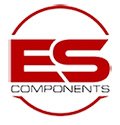Metal-Oxide Silicon Transistor (MOSFET) - What Does This Transistor Do?
The metal–oxide–semiconductor field-effect transistor (MOSFET, MOS-FET, or MOS FET), also known as the metal–oxide–silicon transistor(MOS), is a type of field-effect transistor (FET) that is fabricated by the controlled oxidation of silicon. It has an insulated gate, whose voltage determines the conductivity of the device. This ability to change conductivity with the amount of applied voltage can be used for amplifying or switching electronic signals. The MOSFET was invented by Mohamed Atalla and Dawon Kahng at Bell Labs in 1959, and is by far the most common type of transistor and semiconductor device in the world.
Two power MOSFETs in D2PAK surface-mount packages. Operating as switches, each of these components can sustain a blocking voltage of 120 V in the off state, and can conduct a continuous current of 30 A in the on state, dissipating up to about 100 W and controlling a load of over 2000 W. A matchstick is pictured for scale.
The main advantage of a MOSFET is that it requires almost no input current to control the load current, when compared with bipolar transistors(bipolar junction transistors, or BJTs). In an enhancement mode MOSFET, voltage applied to the gate terminal increases the conductivity of the device. In depletion mode transistors, voltage applied at the gate reduces the conductivity. MOSFETs are capable of high scalability (Moore's lawand Dennard scaling), with increasing miniaturisation, and can be easily scaled down to smaller dimensions. They also consume much less power, and allow higher density, than bipolar transistors. The MOSFET is also cheaper and has relatively simple processing steps, resulting in a high manufacuring yield. The MOSFET is fundamental to building high-density integrated circuits (ICs) and VLSI devices Since MOSFETs can be made with either p-type or n-type semiconductors, complementary pairs of MOS transistors can be used to make switching circuits with very low power consumption, in the form of CMOS logic.
The name "metal-oxide-silicon" (MOS) typically refers to a metal gate, oxide insulation, and silicon semiconductor. However, the "metal" in the name MOSFET is sometimes a misnomer, because the gate material can also be a layer of polysilicon (polycrystalline silicon). Similarly, "oxide" in the name can also be a misnomer, as different dielectric materials can be used with the aim of obtaining strong channels with smaller applied voltages.
The MOSFET is by far the most common transistor used in digital circuits, and is likely the most manufactured device in history. It revolutionized the electronics industry, was central to the microelectronic revolution of the late 20th century, and is the fundamental building block of digital electronics in the information age. MOSFETS are used in tens of thousands of digital products as of 2010 (such as computers and smartphones), and billions of MOSFETs are manufactured every day as of 2013; billions of MOS transistors are often found within a single IC, such as a memory chip or microprocessor. The US Patent and Trademark Office calls the MOSFET a "groundbreaking invention that transformed life and culture around the world"
Source: Wikipedia
